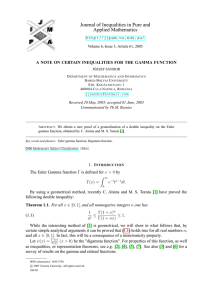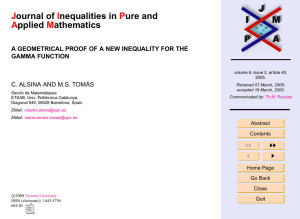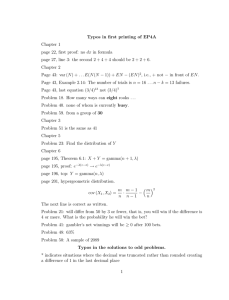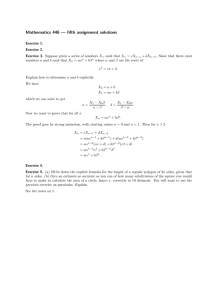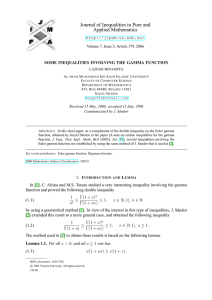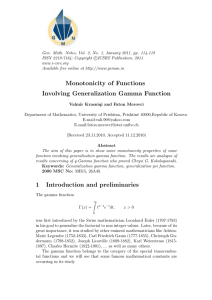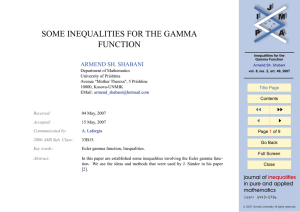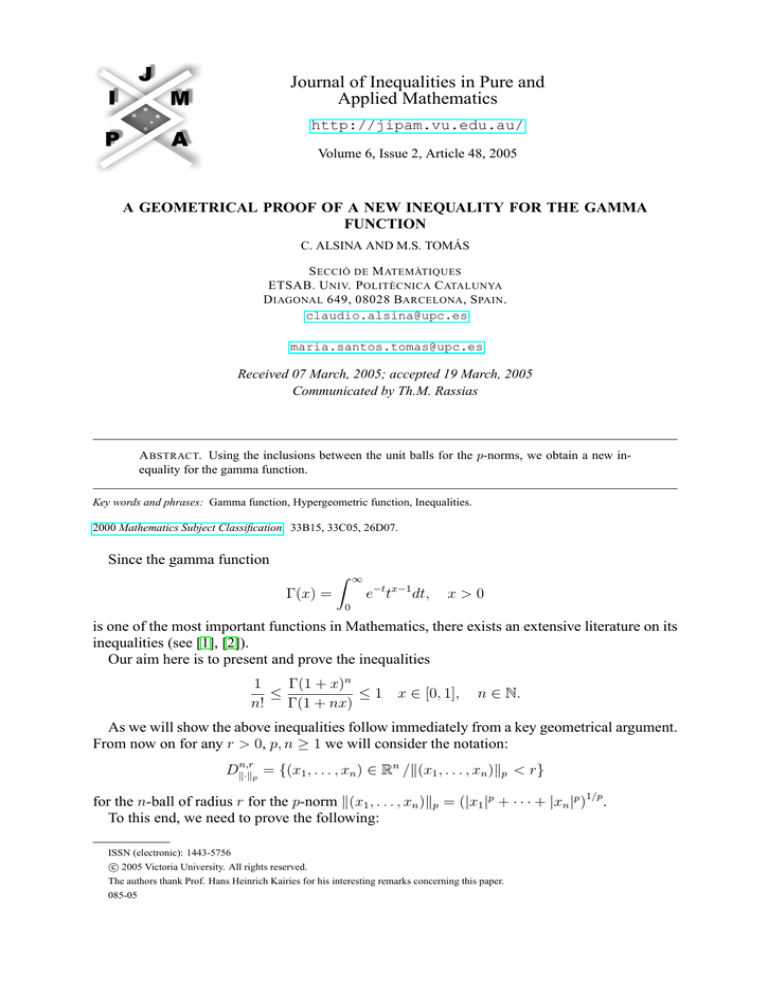
Journal of Inequalities in Pure and
Applied Mathematics
http://jipam.vu.edu.au/
Volume 6, Issue 2, Article 48, 2005
A GEOMETRICAL PROOF OF A NEW INEQUALITY FOR THE GAMMA
FUNCTION
C. ALSINA AND M.S. TOMÁS
S ECCIÓ DE M ATEMÀTIQUES
ETSAB. U NIV. P OLITÈCNICA C ATALUNYA
D IAGONAL 649, 08028 BARCELONA , S PAIN .
claudio.alsina@upc.es
maria.santos.tomas@upc.es
Received 07 March, 2005; accepted 19 March, 2005
Communicated by Th.M. Rassias
A BSTRACT. Using the inclusions between the unit balls for the p-norms, we obtain a new inequality for the gamma function.
Key words and phrases: Gamma function, Hypergeometric function, Inequalities.
2000 Mathematics Subject Classification. 33B15, 33C05, 26D07.
Since the gamma function
Z
Γ(x) =
∞
e−t tx−1 dt,
x>0
0
is one of the most important functions in Mathematics, there exists an extensive literature on its
inequalities (see [1], [2]).
Our aim here is to present and prove the inequalities
1
Γ(1 + x)n
≤
≤ 1 x ∈ [0, 1],
n!
Γ(1 + nx)
n ∈ N.
As we will show the above inequalities follow immediately from a key geometrical argument.
From now on for any r > 0, p, n ≥ 1 we will consider the notation:
n,r
Dk·k
= {(x1 , . . . , xn ) ∈ Rn /k(x1 , . . . , xn )kp < r}
p
for the n-ball of radius r for the p-norm k(x1 , . . . , xn )kp = (|x1 |p + · · · + |xn |p )1/p .
To this end, we need to prove the following:
ISSN (electronic): 1443-5756
c 2005 Victoria University. All rights reserved.
The authors thank Prof. Hans Heinrich Kairies for his interesting remarks concerning this paper.
085-05
2
C. A LSINA AND M.S. T OMÁS
Lemma 1. For all n in N, p ≥ 1 and r > 0 we have:
(1)
Volume
n,r
Dk·k
p
n
Γ 1 + p1
rn .
= 2n n
Γ 1+ p
1,r
Proof. For n = 1, Dk·k
is the interval (−r, r), whose measure is 2r, i.e.,
p
Γ 1 + p1
r
2r = 2 Γ 1 + p1
and (1) holds. By induction, let us assume that (1) holds for n − 1. Then we note that |x1 |p +
· · · + |xn |p < rp is equivalent to |x1 |p + · · · + |xn−1 |p < rp − |xn |p and by virtue of the induction
hypothesis we have
Z
n,r
Volume Dk·kp =
dx1 . . . dxn
n,r
Dk·k
p
Z
r
=2
!
Z
n−1,(r p −|xn |p )1/p
p
0
dx1 . . . dxn−1
dxn
Dk·k
n−1
Γ 1 + p1
n−1
(rp − xpn ) p dxn
=2
2n−1 0
Γ 1 + n−1
p
n−1
Z 1
Γ 1 + p1
n−1
n
n
r
=2
(1 − z p ) p dz,
0
Γ 1 + n−1
p
Z
r
where z = xn /r.
If we consider F (a, b, c, z) the first hypergeometric function (see [3]), then
Z
n−1
1 n−1
1 n
p p
,−
,1 + ,z
(1 − z ) dz = zF
p
p
p
and by well-known properties of the hypergeometric function we deduce:
n−1
Γ 1 + p1
1 n−1
1
n,r
n
n
r F
,−
,1 + ,1
Volume Dk·kp = 2
n−1
p
p
p
Γ 1+
p
n−1
Γ 1+
Γ 1+
Γ 1+
rn
= 2n n
Γ
1
+
Γ 1 + n−1
p
p
n
Γ 1 + p1
n
rn .
=2
n
Γ 1+ p
1
p
1
p
n−1
p
Therefore we have
J. Inequal. Pure and Appl. Math., 6(2) Art. 48, 2005
http://jipam.vu.edu.au/
A G EOMETRICAL P ROOF OF A N EW I NEQUALITY
FOR THE
G AMMA F UNCTION
3
Theorem 2. For all n ∈ N and x in (0, 1) we have
1
Γ(1 + x)n
≤
≤ 1.
n!
Γ(1 + nx)
Proof. For all n in N and p ≥ 1, from the inclusions
n,1
n,1
n,1
Dk·k
⊆ Dk·k
⊆ Dk·k
,
p
∞
1
we deduce
Volume
so by Lemma 1:
n,1
n,1
n,1
≤
Volume
D
≤
Volume
D
Dk·k
k·k∞ ,
k·kp
1
n
1
Γ
1
+
p
Γ(2)
≤ 2n
2n
≤ 2n n
Γ(n + 1)
Γ 1+ p
n
and with 1/p = x, bearing in mind that Γ(2) = 1, Γ(n + 1) = n!,
1
Γ(1 + x)n
≤
≤ 1.
n!
Γ(1 + nx)
From this it follows immediately that the function Γ(1 + x)n /Γ(1 + nx) is strictly decreasing
on (0, 1].
R EFERENCES
[1] H. ALZER, On some inequalities for the gamma and psi functions, Math of Comp., 66(217) (1997),
373–389.
[2] H. ALZER, Sharp bounds for the ratio of q−Gamma functions, Math Nachr., 222 (2001), 5–14.
[3] E.W. WEISSTEIN, Hypergeometric function, [ONLINE: http://mathworld.wolfram.
com/HypergeometricFunction.html].
J. Inequal. Pure and Appl. Math., 6(2) Art. 48, 2005
http://jipam.vu.edu.au/

